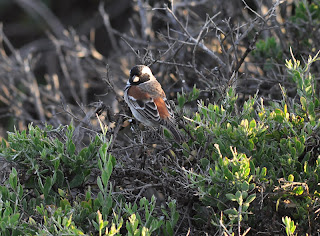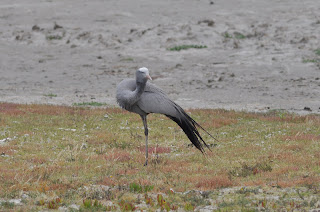Johnston. I organised the trip in two halves, for the first part, we birded areas
around the Cape for a six night stay, including; Kirstenbosch, Strandfontein,
West Coast National Park, Boulder's Beach, De Hoop and other areas.We also
did a pelagic trip with Cape Town pelagics which was amazing! The second part
of the trip inolved an internal flight to J'borg, from there, driving to Magoebaskloof
where we spent two nights. This was followed with six nights in the Kruger National
Park and ending with an overnight stay at Wakkerstroom for the high grassland
specials.
The morning of the 28th Jan' we visited Kirstenbosch Botanical Gardens for our
first taste of South African birding. We notched up forty species to kick start the
trip list, including Cape Sugarbird and Cape Siskin. The highlight for me was a
Spotted Eagle Owl that sat out in full view.
Later in the day we visited Kommetjie, a coastal site that contains a Swift
Tern roost as well as a selection of endemic Cormorants. Around 200 Swift Terns
were sat on the rocks in the bay along with good numbers of Hartlaub's and Kelp
Gulls. African Black Oysterctcher, White-fronted Plover plus Cape and Bank
Cormorants all vied for attention. During the excitement, i'd left my rucksack
on the beach which contained camera lenses and money. Thankfully, it was still
there when i went to collect it five minutes later. We finished the day tired and
sunburnt and after a tasty meal in Cape Town tried to get to bed early for the
pelagic trip the next morning.
Kirstenbosch
Helmeted Guineafowl
Hadeda Ibis
Spotted Eagle Owl
Cape Bulbul
African Dusky Flycatcher (juv' and adult)
Cape Sugarbird
Hartlaub's Gulls with Swift Terns
Swift Tern
White-fronted Plover
African Black Oystercatcher
We left Hout Bay for the pelagic trip at 7.30 and with four other birders on the small
boat, headed 25 miles offshore to watch the various seabirds feeding alongside a fishing
trawler. The numbers, variety, and views of the birds was simply amazing! You could
almost touch some of the White-chinned Petrels that numbered in their thousands.
During the seven hours or so at sea we also saw the following: 40 Shy, 4 Indian Yellow-
nosed and 15 Black-browed Albatross'. 1 Flesh-footed, 1 Manx, 50 Great, 400 Cory's
and 200 Sooty Shearwaters'. Wilson's and European Storm Petrels, Pomarine and Sub-
antarctic Skuas, Giant Petrel sp',Sabines, Hartlaub's and Kelp Gulls and 2 African
Penguins.
On the way back to the harbour the swell on the sea had eased and around twenty or so
Dusky Dolphins swam alongside the boat with at least three Humpback Whales seen at
close quarters too!
Of the eight birders on the boat, half were sick, including me. The ride out was very choppy
with lot's of spray, definately not a trip for the half-hearted.
Cape fur Seal
Shy Albatross
Indian Yellow-nosed Albatross
Cape Gannet
Flesh-footed Shearwater
European Storm Petrel
Flesh-footed Shearwater
White-chinned Petrel
Black-browed Albatross
Wilson's storm Petrel
White-chinned Petrels
Shy Albatross
Shy Albatross
Great Shearwater
Sabine's Gull
Sooty Shearwater
Shy Albatross with Great Shearwater
Back on shore and later in the day we made a whistle stop visit to the Penguin colony at
Boulder's Beach, very cute, before heading to Strandfontein sewage works. We only
had a couple of hours at the site before dark but managed to see a large number of
water birds and waders. Kittiltz's Plover, Moccoa Duck, Hottentot Teal, African Marsh
Warbler and Fish Eagle were among others added to the growing list.
Boulders' Beach, Simonstown
African Penguin
White Pelican
Blacksmith Plover
Steppe Buzzard, very common over open country
African fish Eagle
Day three (30th Jan) and we headed to the West Coast National Park. It took a little
over an hour to reach the site from Cape Town and the bird on our wish list here was
Black Harrier. We had at least three sightings during the day, all male birds. Other high-
lights were 5 Chestnut banded Plover, thousands of Curlew Sandpiper, Terek Sandpiper,
Ostritch, Southern Pale-chanting Goshawk, Cape Bunting, Karoo scrub Robin and Cape
Penduline Tit. What stole the show was a superb Caracal that showed itself from one of
the hides at the reserve.
Caracal
boardwalk to one of the hides
Ostritch
Andre, photographing Speckled Pigeon on the nest
Cape Teal
juvenile Yellow-billed Kite
male Cape Sparrow
White-throated Swallow
Karoo scrub Robin
Curlew Sandpiper
Rock Kestrel
Cape Weaver
African Cobra being released by a member of the park staff
Black Harrier
31st Jan, we headed further from Cape Town to De Hoop nature reserve, stopping
on route at Sir Lowry's Pass to look for Cape Rockjumper. We failed to find the
Rockjumpers but were compensated with the rarely seen Hottentot button-Quail
which we flushed from besides a track. Other interest came with, Cape Grassbird,
White-necked Raven, Orange-breasted Sunbird, Cape Siskin and Familiar Chat.
Pressing on, we reached De Hoop later in the afternoon and spent two nights on the
reserve staying in a rondavel by the lagoon, superb!!!
We added 23 new birds to the trip list including Southern Tchagra, Blue Crane, Cape
Vulture, Lesser Honeyguide, Denham's Bustard and unusually a Common Redshank!
The car park at Sir Lowry's Pass with 'our' Ford Ikon
a big bird!
Browse line at De Hoop
Koppie Alleen, De Hoop
the view from the accomodation
Rock Hyrax
Blue Crane
White Pelicans
African Hoopoe
Otters and Black-winged Stilt
Water Thick-knee
Bontebok
Three-banded Plover
Caspian Tern
Bokmakierie
Capped Wheatear
De Hoop was a great place to stay. Birding was on the 'doorstep', the lagoon in particular
was simply teeming with birds. We left early on Feb' 2nd for a long drive to Cape Town
to catch a flight to J'borg. This day was spent mostly travelling, inspite of this we still added
another four species to the trip list which stood at 190 from leaving Cape Town. We arrived
late at 'the Birder's Cottage' in Magoebaskloof and arranged to meet our guide early the
following morning for some forest birding.
3rd Feb' Magoebaskloof, our guide helped find several tricky species, which on our own,
would have been very difficult. Cape Parrot, Narina Trogon, and Bat Hawk were just some
of the specials we saw.
Cape Parrot at roost site
Gurney's Sugarbird
Yellow Warbler (chloropeta natalensis)
Long-crested Eagle
Cuckoo Hawk
Kurrichane Thrush
Drakensberg Prinia
Bat Hawk
Jackal Buzzard
Forest Buzzard
We used the guide the following morning (4th feb) and concentrated on more open habitat.
Sabota, Short-clawed and Rufous-napped Larks found their way on to the list. Long-billed
and Plain-backed Pipits also. After lunch, we left for Kruger making a detour along the way
for one of the rarest raptors in Africa, the Taita Falcon.
The Falcon can be found on the steep cliffs near the J G Strydom tunnel. We arrived at
the hottest time of day and a group of women who ran the curios stalls helped us in our
search.With only ninety minutes to spare, we became a little worried as there was no sign
of the birds on the cliffs or in the air. Fortunately, a bird swooped in at lightning speed
and landed, panting on the cliff face. Another bird circled the area a few times before
dissapearing, result!
the cliffs near the J G Strydom tunnel
After some refreshments we set off for Satara Rest Camp in the Kruger National Park.
The roadside to the camp was littered with Shrikes, Rollers and Raptors and it took
longer than expected to get there. We made it to the Camp before 6.30pm and couldn't
wait to get out birding the following day.
The next morning started with a torrential downpour. So much so, that we had no option
but to wait until it cleared. Thankfully, a couple of hours later the rained eased and we set
off exploring the tracks and roads nearby. One condition of being in Kruger is that you
are not allowed to leave your vehicle (except at bird hides,etc) so it's a question of stop,
start and leaning out. The birds allow close-up views because of this and during our time
there we were treated to some amazing sights with the van acting as a mobile hide.
Southern red-billed Hornbill
Arrow-marked Babbler
Striated Heron
Croc'
Carmine Bee eater with Barn Swallows
Striated Heron
European Cuckoo
Woodland Kingfisher
The second night of our stay at Satara Camp we went out on a night drive. These are
three hour trips from 8pm-11pm to search for game and of course nocturnal birds. I
was amazed how good it was, we saw at least 20 Bronze-winged Courser, 40 Water
thick knee, 10 Nightjar, 3 Southern white-faced, African Scops, and Barn Owls. In
addition to which Spotted Hyeana, White Rhino, Buffalo, Jackal, Genet and many other
animals.
Night drive
Mozambique Nightjar
This African Wildcat was patrolling camp on our return
The nights of the 6th and 7th of Feb we spent at Skukuza Rest Camp and every day
brought new birds.
Bataleur
Didric Cuckoo
Lilac-breasted Roller
Southern White-crowned Shrike
Southern Ground Hornbill
Red-backed Shrike
Swainson's Francolin
Impala with Red-billed Oxpeckers
Little Swift
Wire-tailed Swallow
'our' home at Skukuza
Rufous-napped Lark
Helmeted Guineafowl
Yellow-throated Longclaw
Chacma Babboon
Blacksmith Plover
Sothern Carmine Bee-eater
Brown Snake Eagle
White Rhino
This Black-bellied Bustard posed by the roadside
Egyptian Goose, Croc, Laughing Dove and Turtle
Steppe Buzzard
Buffalo
Cheetah
Vervet Monkey
Elephant
Mouse-coloured Flycatcher
Impala
Martial Eagle, one of five we saw in Kruger
The grounds of the rest camps are big enough to spend an hour or so birding and in fact
some birds we saw only within the camps.
Black-collared Barbet
Skukuza camp
African scop's Owl roosted in the restaurant at Satara
These Banded Mongoose were inside camp
fortunately this Spotted Hyena was outside
Purple-crested Turaco was seen at two rest camps
Satara
Little Swifts
Groundscraper Thrush
Satara
Rondavel
After Skukuza Rest Camp we had a night at Pteroriuskop which saw us add another
ten birds to the trip list: Grey Penduline Tit, Grey-headed Bush shrike, Reitz's helmet
Shrike and Striped Kingfisher were among them.
Our final night in the Kruger was spent at Berg-en-dal. A dam at the camp contained
a roost of White-fronted Bee-eaters in the over-hanging trees.
On the morning of 10th Feb' we left Kruger for our final night in South Africa at
Wakkerstroom. This site is well known for it's high grassland endemics and with
the help of our guides we saw most of them. We arrived at 1.30pm and after
quickly checking in at Birdlife's Wakkerstroom centre we met our guide for an
afternoons birding.
We had masses of Amur Falcons, although we saw lot's in Kruger it was nothing like
the numbers or views here at Wakkerstroom. 300 birds lined the fences on one track!
Over the next few hours we added Southern Bald Ibis, Ground Woodpecker, Ant-eater
Chat and the rare Botha's Lark and Yellow-breasted Pipit.
Next morning we saw Rudd's Lark, African Cliff Swallow, Bush Blackcap, Mountain
Wheatear, Blue Koorhan and our first and only African Snipe.
Yellow-breasted Pipit
Amur Falcon
Cape Longclaw
Ground Woodpecker
Pale-headed Cisticola
our guide Lucky
With most of the specials seen, we had pushed the species total for the trip to 403.
Not too bad for two weeks. In the afternoon we headed for J'borg and keeping a
quiet eye on the cereal fields for Secretarybird along the way. We failed to spot one,
there's always next time!








































.JPG)










































































































Brilliant stuff Gaz, keep em coming :)
ReplyDelete